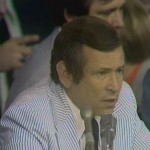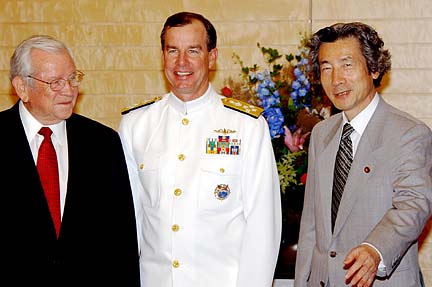Amb. Henry F. Cooper, Chairman . . . Lt. Gen. Daniel Graham, Founder
High Frontier . . Building Truly Effective Defenses . . Reagan’s Vision Lives
E-Mail Message 140630
Howard Baker R.I.P
By Ambassador Henry F. Cooper
June 30, 2014
Howard Baker, with a lifetime of distinguished public service, accomplished many things for the American people. Among those many accomplishments, those of us missile defense advocates should be grateful for his role, as our Ambassador to Japan, in establishing the joint U.S.-Japanese Aegis ballistic missile defense program that has produced numerous BMD capable ships on patrol around the world. May he rest in peace.
I hope last Monday’s message was not a bad omen for Senator Howard Baker, when I recalled his famous question, “What did the President know and when did he know it?” I like many Americans am saddened by his passing on June 26th.
I was glued to the television during the Watergate Hearings and was impressed by the deliberate manner of this young senator from Tennessee. That admiration continued at a distance through the remainder of his impressive public service career, which included his becoming Senate Majority Leader and his critically important contributions as White House Chief of Staff during the Iran-Contra crisis of President Reagan’s second term.
He was known during these times as “the Great Conciliator.” Most of all I will never forget his important and generally unrecognized contributions to the success of the Aegis ballistic missile defense (BMD) system.
As President George W. Bush’s Ambassador to Japan, he arrived in Japan just as Japan’s often turbulent politics were stabilizing under prime minister Junichiro Koizumi, who forged a close bond with President Bush and took the landmark decision to send troops on a reconstruction mission to Iraq—the first time Japan had sent forces to such a conflict zone since World War II. Below is an AP picture of Ambassador Baker and ADM Thomas Fargo, then the new commander of the U.S. Pacific Command, at Prime Minister Koizumi’s official residence in Tokyo on May 15, 2002.
While serving in Japan, Ambassador Baker continued his advocacy of ballistic missile defense begun during the Reagan administration, particularly by encouraging the Japanese to join forces with the U.S. efforts to build effective BMD systems—particularly those that could help Japan defend itself from the growing threat from North Korea.
In the late 1990s, North Korea had begun testing its ballistic missiles, overflying Japanese territory and threatening the United States as well. They were also developing nuclear weapons which could be delivered by these ballistic missiles—so these activities were threatening to us and the Japanese.
In these latter days of the Clinton administration—which had sharply cut our BMD development programs, the U.S. Congress passed a law making it U.S. policy to develop a BMD system to counter this threat—and work began to prepare to build our current ground-based interceptor (GBI) site on Ft. Greely, Alaska.
I had been an advocate for building sea-based BMD systems since my Strategic Defense Initiative (SDI) watch, when we initiated that important program in 1991 during the George H.W. Bush administration. By the early 2000s, the Aegis BMD program was at a critical stage and there were debates about the design of its interceptor.
Some wanted a large interceptor booster to achieve a high burnout velocity using the same technology being developed for the GBIs. Had they won that debate, a larger vertical launch system (VLS) would have been required and the resulting expensive fleet retrofit program would probably have led to Navy opposition to its development.
The big interceptor proponents might well have won that argument, but the Japanese, who agreed to bring money to the table to join in the Aegis BMD development effort, insisted on using the Standard Missile-3 (SM-3) booster—slower to be sure, but available much sooner and without an expensive major retrofit program.
I don’t know the details, but Ambassador Baker was in the middle of those negotiations, the Japanese won the debate and the rest is history, as they say. The Japanese have been full partners ever since, sharing costs, engaging in joint tests and deploying their own Aegis BMD ships.
The Navy’s (and RADM Wayne Meyer’s) “build-a-little, test-a-little, learn-a-lot” philosophy in developing Aegis has produced the most enviable record of all our BMD development programs—28 successful intercepts out of 34 attempts since 2001, all conducted by operational crews. And it was the system of choice in 2008 to shoot down a dangerous satellite that threatened to spread toxic fuel upon reentry—making a grand total of 29-for-35 attempts, an 83-percent success rate.
We now have 30 Aegis BMD ships deployed around the world (growing to 33 by the end of the year)—and Japan has 4 Aegis BMD ships, with several more Aegis ships that may become BMD capable. And there is more to come, including Aegis Ashore sites in Europe and hopefully here at home.
I have often thanked our Japanese allies for their persistence in that important debate in the early 2000s—I firmly believe that if those arguing for the larger interceptor had won, the Navy would never have approved the major retrofit program. And we would have nothing today.
I never got the opportunity to thank Howard Baker for his role in that key debate—my major regret. May he rest in peace.
Next Steps.
We should continue, as a top priority, to support a robust Navy program office to continue its Aegis BMD development activities—and make Aegis BMD all it can be, at sea and on the land.
These programs are currently focused on benefiting our overseas troops, allies and friends. These efforts—to develop sea-based and ground-based interceptors— should be expanded to defend Americans at home from North Korean and Iranian nuclear weapons carried by:
- Intercontinental ballistic missiles (ICBMs) launched over the North Polar regions;
- Short, medium and intermediate range ballistic missiles launched from vessels off our coasts, especially from the Gulf of Mexico, and Central America (e.g., Venezuela; and
- Satellites, especially that approach the U.S. from over the South Polar regions.
Such programs would honor Howard Baker’s contributions better than any words could ever do.
What can you do?
Get involved— Help us to spread our message to the grass roots and to encourage all “powers that be” to provide for the common defense as they are sworn to do.
Begin by passing this message to your friends and suggest they visit our webpage, www.highfrontier.org for more information. Also, please encourage your sphere of influence to sign up for our weekly e-newsletter!
Please click here to read Past Weekly Updates!
Please click here to read past Flash Messages!
Please help High Frontier continue this important and timely work!
Be sure to follow us on our Social Sites!
If you found this letter via our Social Sites, and you would like to subscribe, click below!







